Readers Write 2019
Wisconsin Natural Resources magazine encourages reader photos and feedback. Below, you will find letters that appeared in 2019 magazine issues. Reader letters from other recent years are available here:
Reader letters and other content from older issues of Wisconsin Natural Resources are part of the magazine archives housed in the UW-Madison Libraries Digital Collections [exit DNR]. (Note: Magazine content from 1996 and newer is being added to the UWDC site, so some of those years may be temporarily unavailable.)
We welcome your feedback! Email us at dnrmagazine@wisconsin.gov or mail to:
Readers Write
WNR magazine
PO Box 7921
Madison, WI 53707
Winter 2019
Winter 2019
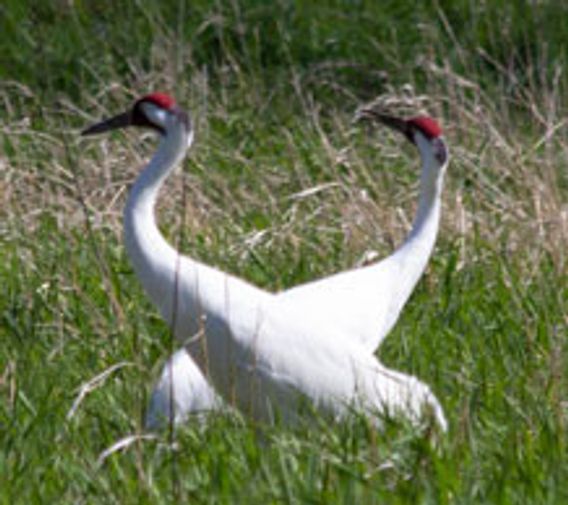
BOUNTIFUL BIRD WATCHING
On May 25, we spotted a pair of whooping cranes at the Horicon Marsh Wildlife Refuge. We have attached a photo. We also spotted a black crowned night heron on Ledge Road, which is just south of Highway 49. Later, we spotted an eagle and a couple of juveniles just south of 49.
Jim and Bonnie Halper
Kewaskum

SUNSET FISHING
I took a picture of my oldest son fishing at Franklin Lake and thought it would be very neat to be in the magazine. Thanks for your time.
David Sackett
Rhinelander

BLACK EARTH BEAVERS
This photo was shot along Black Earth Creek, 2 miles west of Cross Plains, during a high water event. It shows an adult beaver and four little ones. Enjoy!
Dan Buckland
Cross Plains

SMELT YEARS AGO
It took me a while to find this picture (smelt was featured in Spring 2019 “Back in the day”). It was taken by Earl Johnson, my godfather, who was chief photographer for the Duluth Herald and News Tribune. He and others had been trying to get a picture of the smelt in the water for some time.
He was finally able to get this picture in the spring of 1959, I believe, but it could have been a year either way. It was taken on the Lester River on the east end of Duluth. That’s me in the picture. I think this was published in a Minnesota outdoor periodical.
Jim Morris
Berlin
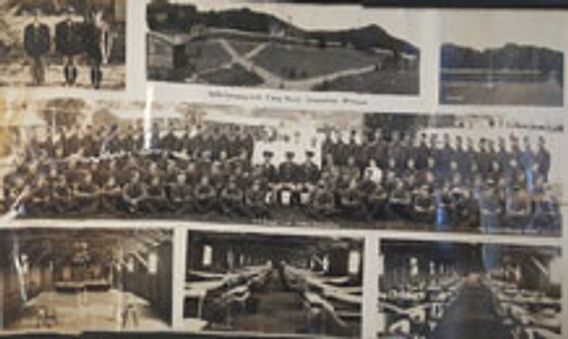
REMEMBERING THE CCC
I found the write-up on Perrot State Park (Summer 2018) while searching for info on the Civilian Conservation Corps’ Camp Perrot. My father, Orvis E. Fry, was there in late 1930s and he saved a picture, which I’m attaching for your use.
He was training as an orderly/medic with the doctor. He was from Salem, Illinois, and was born in 1918. Camp Perrot must have made a lasting impression on Dad, as he stayed in the medical field for the rest of his life. He ended up as a surgical X-ray technician and finally retired in 1988 from Mount Sinai Hospital in Miami Beach.
Kenneth D. Fry
DeLand, Florida
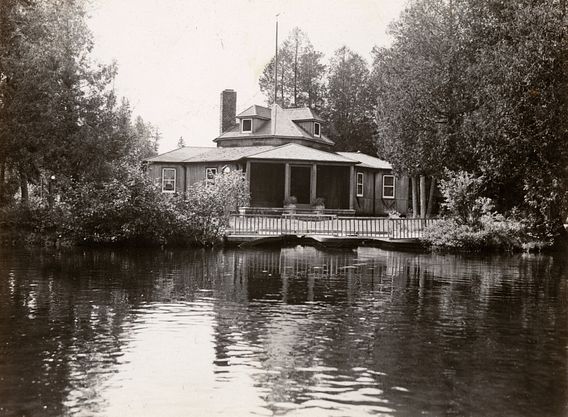 © STABER W. REESE
© STABER W. REESEPERSONAL CONNECTIONS
I was pleased to see several articles with a personal connection in the Summer issue. Mary Kohler (“A comeback for the ages”) is a sister to a longtime bird hunting and fishing friend, the late David Stewart, whose family built summer homes on Pine Lake east of Chetek over 100 years ago. They also had a home on the Brule (“Life’s better on the Brule”). I was lucky enough to go on some adventures with Terry Kohler and Dave.
When I turned to “Back in the day,” I was reminded of my favorite outdoor author, Wisconsin native Gordon MacQuarrie. He mentions the Pierce Estate (above) in several stories. At 80, my legs do not allow me to go into places like the Van Vliet Hemlocks (“Outside in Wisconsin”), but we made trips in there several times in the past.
Bill LaVelle
Belvidere, Illinois
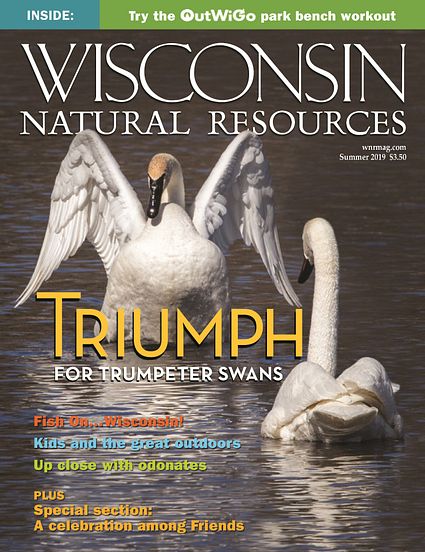
GREAT READ — AND MAKE IT A 185
The cover on your Summer 2019 issue caught my eye when retrieved from our mailbox. Trumpeter swans are something I get to see mostly in the fall, as our bush cabin on Quartz Lake, Alaska, is a big staging area for these birds on their return trip south.
I will never forget a trip on Oct. 5 in the ’90s to check the cabin before lake freeze-up. When I arrived, the lake was fogged-in, but I quickly realized I was assuredly not alone. These big birds were everywhere and their calls and “talking” drowned out my outboard. By the time I was ready to return, I was able to see fairly well. I could not believe my eyes — not hundreds but thousands of swans! Every year since I try to make that late run to the cabin.
And then the big surprise when I had a chance to read the article (“A comeback for the ages”). I had left the University of Wisconsin-Whitewater to venture “north to the Last Frontier” and the University of Alaska in Fairbanks. Over the years, I had my most incredible waterfowl hunt in Minto Flats. So I really appreciated the timely article going back 30 years.
But I do want to point out: Knowing of pilot Rod “Sky” King and also having been involved in a world-class fishing lodge using Cessna 185s and 206s, the reference to a “Cessna 187 float plane” should be a 185. I believe there was only one 187 made and the probabilities it somehow was converted to floats, well, make it a 185.
E. Thomas Robinson
Fairbanks, Alaska
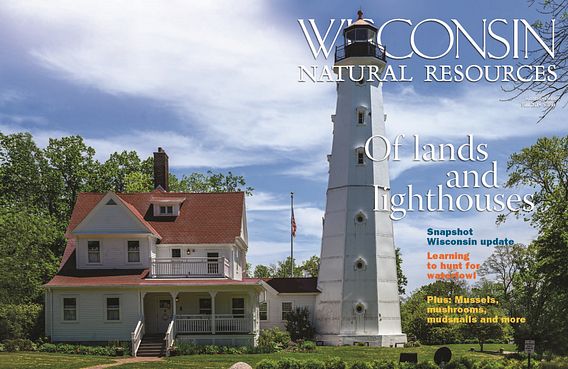
NICE FEEDBACK FOR FALL ISSUE
Many thanks for the wonderful Fall issue. It is full of interesting articles on a wide variety of subjects, as well as important information about the resources and how to become involved in specific efforts or places. Under the leadership of Secretary-designee Preston Cole, whose essays I greatly appreciate, there is obviously a renewed commitment to the mission of the Department of Natural Resources. Carry on, please.
Sharon Gaskill
Black Earth

NATURALLY TALENTED
My name is Halley, and I recently graduated from the University of Wisconsin-Madison with a degree in conservation biology and environmental studies. In my free time, I have always enjoyed drawing and painting, and have recently completed this piece representing “Mother Earth” and the intersection of water (blue waves that make up the hair) and land (animals, leaves, branches).
This piece is not like others I have done. Rather, it is esoteric. It explores the relationship between ecology and human nature. Our environment is just as much a part of us as ourselves.
My family and I love your magazine. I grew up in Appleton, preferring to play in the grass rather than on the carpet. I am very passionate about the environment and working to present the natural world as something the public will take interest in, advocate for, and appreciate. I hope to use my passion for the environment to preserve biodiversity in parks and ecosystems around Wisconsin.
Halley Feil
Madison
After sending in this submission, Halley ended up coming to work at the DNR as a natural resource program specialist in the Division of Fish, Wildlife and Parks. Welcome, Halley!
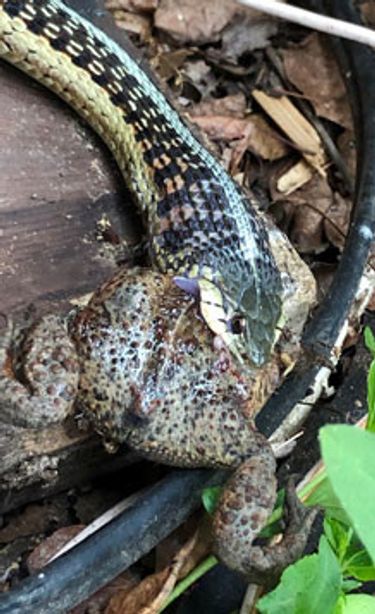
ONE BIG GULP
I relocated to the beautiful Northwoods last August. I was in Colorado for 27 years and thought that was a beautiful state, but Wisconsin is beyond amazing! I came across your publication at the Marshfield Clinic and immediately subscribed. There is so much great information.
I wanted to share a cool picture I caught. I only wish I’d had a chance to grab my camera — thank goodness for cell phones! The timing was amazing. Thank you for such a great magazine. It’s a wonderful resource for newbies!
Marlowe Hodge
Land O’ Lakes
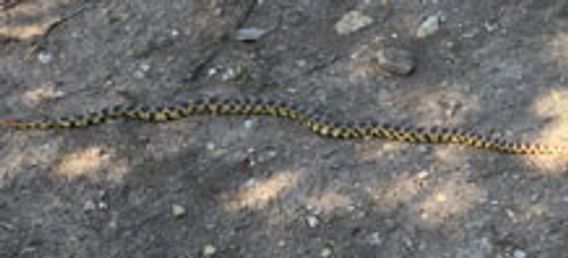
MORNING VISITOR
This bullsnake was at our front door this morning! We just moved to the Town of Sevastopol and built a new house. It is a fun time experiencing new flora and other life forms in our new home.
Merry Demske
Door County
Rori Paloski, DNR conservation biologist who specializes in herpetology, replies: “The snake in the photo looks similar to a bullsnake (also called a gophersnake) but is actually an eastern foxsnake. The eastern foxsnake is found throughout Wisconsin, while the bullsnake is restricted to the west-central portion. The two species are differentiated by their patterning — the bullsnake has patterning on its head, whereas an adult foxsnake has a solid colored head. The spot pattern on the body also differs slightly between the two. Both species are non-venomous but are considered rattlesnake mimics; when threatened, they will ‘rattle’ their tail, hoping to scare off any potential predators. Not only do they look like a rattlesnake when they do this, but the vibration of their tail against dry leaves, gravel or vegetation often produces a rattling noise that can sound very much like a rattlesnake — just what they are hoping for!” To report sightings of snakes and other species, visit wiatri.net/nhi [exit DNR].
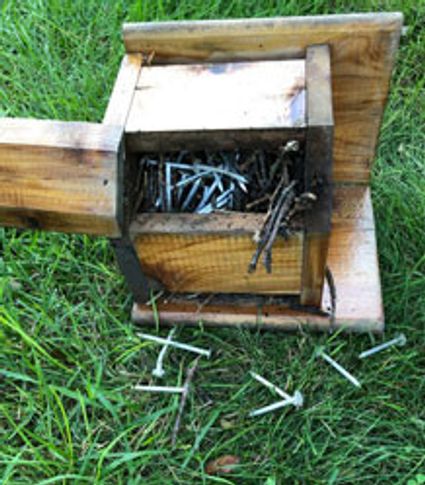
BUILDING A BETTER BIRD NEST
I thought you might be interested in this picture. I started cleaning out a wren house from our back yard to get it ready for next spring. When I opened the bottom to clean out the sticks and fluff, I also found aluminum nails. There turned out to be 35 of them. Our neighbors were putting on new siding, and I assume the wren “borrowed” a few to glitz up the nest.
Gary Rhines
Walworth
DNR conservation biologist Ryan Brady replies: “It is typical of house wrens to fill cavities with small sticks. Often, one male will do this in several cavities or boxes within his territory, even though the female will ultimately only nest in one of them. In some cases, nails, tacks, hairpins, paper clips and other metal items that mimic the size and structure of small twigs will be used. So while it’s not common to find a nest box full of nails, it’s not entirely rare or unexpected either.”
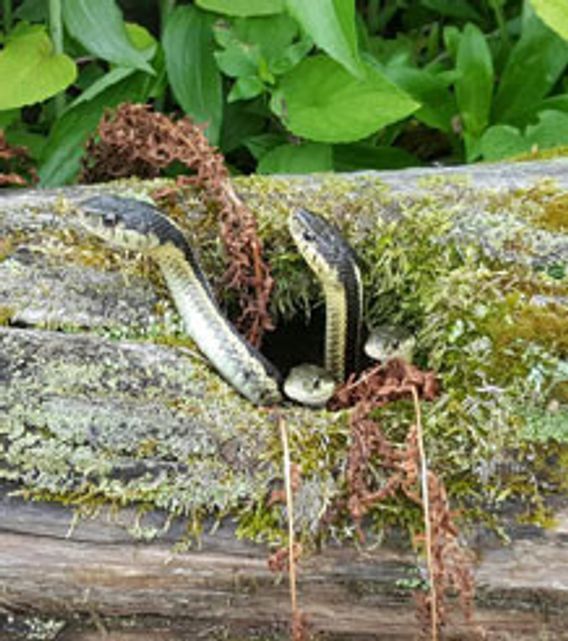
GARDEN COMPANIONS
My flower gardens are filled with many common garter snakes. They slither away quickly when I’m weeding the garden and they ignore the dogs or vehicles as long as they stay a few feet away. They seem to know they are safe. But when my husband, Jeff, comes out to the garden in the morning, the snakes come out to greet him. Some even follow him to the compost pile and wait to be given a worm. They seem to recognize him.
Snakes are great! They eat garden pests and some unfortunate toads and frogs. Feeding snakes is less messy than feeding birds and it does not attract bears. Here’s a picture of the snakes that live for the summer in our yard.
Diane O’Krongly
Mercer

SUMMER TANAGER SIGHTING
I was just reading about the summer tanager on your website. This guy was at my feeders in Jacksonport.
Kathy Navis
Jacksonport

RARE RACCOON
Is this an albino raccoon? I saw it on the east side of Highway 38 south of Four Mile Road (in Caledonia). The Root River meanders a short distance from that side of the road and there are natural areas around the river.
Steven Sandberg
Racine
Curtis Twellmann, DNR furbearer ecologist, replies: “This aberrant pelage pattern is commonly referred to as a ‘blonde’ raccoon and is an example of leucism — or the reduction of, but not complete elimination of, melanin/pigment. While not as rare as albinism, this is still pretty rare. Leucistic animals can generally live normal lives, as they usually lack the other related genetic deficiencies like poor eyesight that hamper true albino critters. Neat find!”
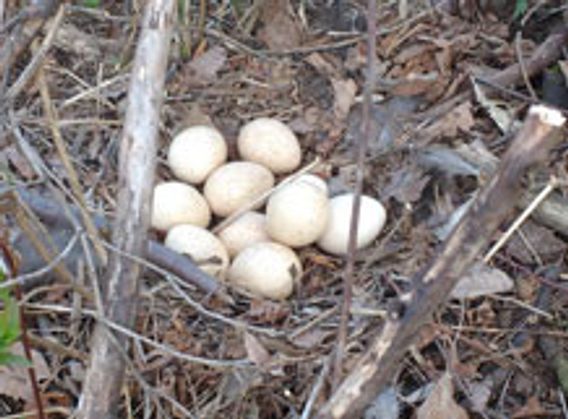
SHY HEN STAYS OUT OF THE PICTURE
I am attaching a photo of turkey eggs I spotted along our road. The hen didn’t want to be in the picture.
Margie Novak
Kennan
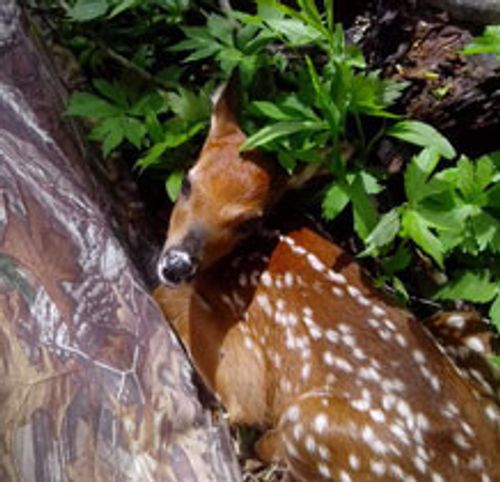
FAWN FINDS PERFECT COVER
When getting back to our cabin to pull my spring turkey hunting blind, I found this little one still using it. Just wondering, are the Wisconsin deer getting wiser and
using “deer blinds,” too?
Doug Kurschner
Almena
Thanks for the photo, Doug. And it serves as a good way to remind everyone to help Keep Wildlife Wild. Early on, fawns move very little and rely on their camouflage coat and lack of scent to hide them while the mother largely stays away to keep possible predators at a distance. If a fawn is found lying alone, unless obviously sick or injured, Keep Wildlife Wild and simply leave it be. Learn more at the DNR's Keep Wildlife Wild webpage.
Fall 2019
Fall 2019
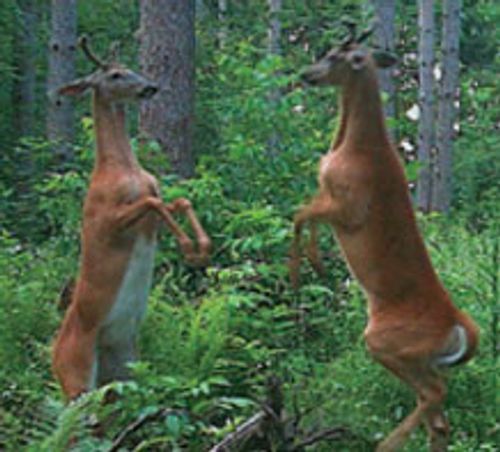
DEER LIKE A MIRROR
I have taken this picture of two bucks practicing on my property in Deer Park — almost looks like a mirror picture. Just thought you might be interested in publishing it.
Bob Krueger
Deer Park

HAVING HIS DAY AT DEVIL’S LAKE
Here’s a photo of my dog, Zeus, at the dog swim area at Devil’s Lake State Park.
Denise Tincher
Baraboo
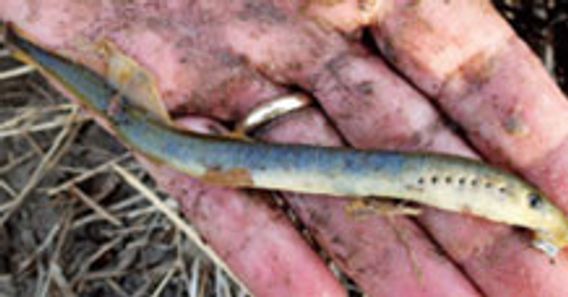
LOW-DOWN ON LAMPREY
While chasing trout, I saw some odd feeding on the surface. The big trout were smashing what looked at first glance like baby snakes. It was not constant. I dismissed it and later caught a decent brown and it regurgitated this.
I have seen these in the past but have never seen trout feed on them. They signify a healthy stream. They are American brook lamprey, I believe. They are not a parasite like their relatives. They feed on tiny things on the bottom. Their mouth is not developed enough to attach to a host. They have a very short window for breeding. They are native species and an imperiled species. They obviously are tasty to big trout.
Len Harris
Richland Center
DNR fisheries biologist Karl Scheidegger replies: "Yes, there are three nonparasitic lampreys in Wisconsin — American brook Lamprey, northern brook lamprey and southern brook lamprey. This appears to be an American brook lamprey. It inhabits the headwaters of cool, clear streams over sand and small gravel. It prefers small-sized streams, occasionally medium-sized rivers. Common fish associates are sculpins, brook and brown trout. It is a food for sport fishes and provides an important link in the food chain. It is sensitive to pollution, especially turbidity."
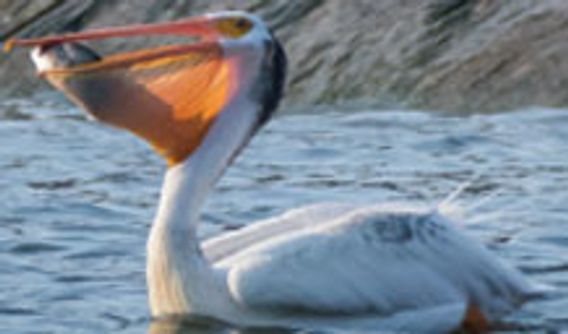
WATERFRONT DINING
White pelican in Menasha.
Harold W. Boccheciamp
Neenah
Summer 2019
Summer 2019
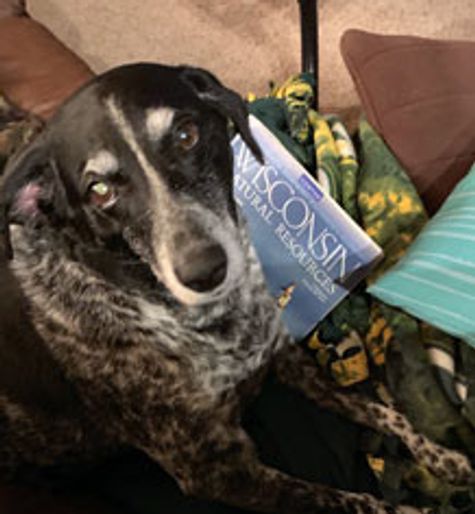
ONE SMART PUP
We love reading your magazine (the pictures are amazing) and are avid patrons of the Wisconsin Department of Natural Resources — hunting, fishing and camping in Wisconsin state parks, of course with our dog, Trigger, by our side. Caught Trigger on the couch with the lighthouse issue one evening. Perfect photo op!
Larry and Gina Fritz
Sullivan
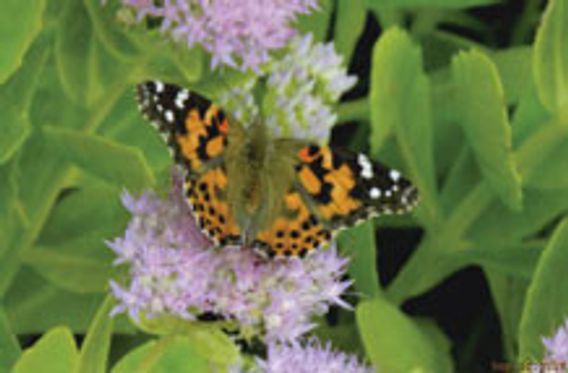
IS THAT A REGAL FRITILLARY?
As I got to the last page of the Natural Heritage Conservation insert (Winter 2018) and saw the beautiful butterfly, I said, "I've seen that butterfly on my flower bush right outside my front door." I took several pictures of them, as there must have been a dozen going from flower to flower, the same flower (I think) that's in your picture. Anyway, I made an 8x10 copy of the photo and it is in my office where I look at it every day. Keep up the good work!
Jim Pat Patterson
Oshkosh
DNR conservation biologist Jay Watson replies: "The butterfly in the photograph is a painted lady butterfly. Some years they are pretty abundant in Wisconsin and other years almost absent. The reader's photo is dated from 2017 and that was a great year for painted ladies in Wisconsin."
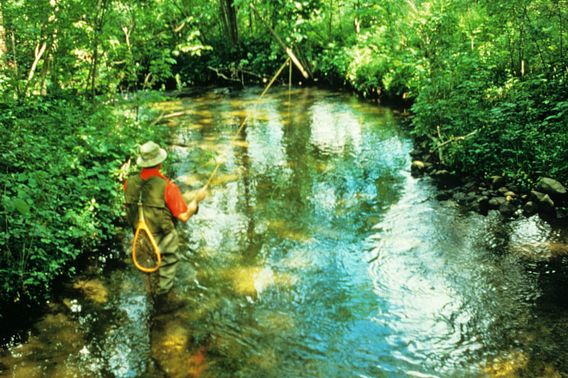 © DNR FILES
© DNR FILESODE TO ANGLING
I am a communications instructor at Fox Valley Technical College in Appleton, and I wrote a sonnet about the stages Wisconsin anglers often go through: They want to catch the most fish, then they want to catch the largest fish, then they want to catch the most difficult fish. Through it all, however, they practice catch-and-release and keep their trophies only in their memories.
I am sending you this poem with the hopes that you might print it in your fine magazine. I have subscribed to Wisconsin Natural Resources for years, and it is a very informative, useful magazine. It has helped me plan weekend excursions while teaching me about the natural goings-on around our great state of Wisconsin.
Jonathan Walter Iwanski
Appleton
An Angler's Cycle
The novice aims to bring to hand the fish
of greatest number, only hoping
that high Pisces hears and answers his one wish
and tells him where His blessed goals are at.
With time behind, the next aim is for size,
for quality's own definition tends
to change with he that hopes to think he's wise –
the standards sometimes change from what to when –
as the next stage for anglers comes to pass:
not number, shape, or any such like goals;
but just how difficult it was to catch
this finned creature making him feel whole.
Although I do not grasp to kill and eat,
I think my trophy always for to keep.
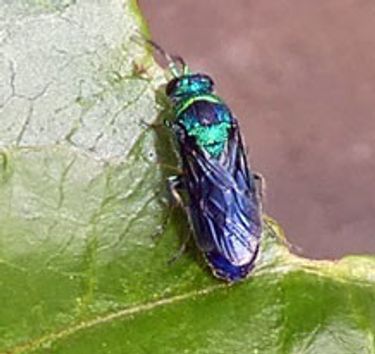
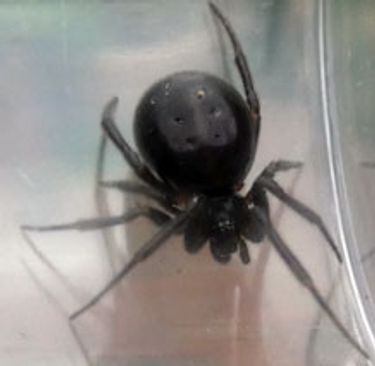
WHAT KIND OF BUGS?
I have a healthy respect and a cautious admiration for spiders. I came across this small spider, only 7 millimeters long from abdomen to eyes. It is all black with no distinct marking, four dimples on the back and a reddish tinge near the joints of the legs. On the underside is a lighter brown area and a small whitish semi-circle. Having seen black widow spiders out West, this one looks similar but has none of the red markings. The closest possible match I can find after searching internet bug ID sites is a false widow or rabbit hutch spider.
I also photographed a small wasp and after much searching I believe it is a cuckoo wasp. I'm 60 and spent my life outdoors and never heard of one before. It is almost a metallic-looking green and blue and seems to like my passionfruit plant the best. Did my inner bug-nerd get the correct IDs?
Red Simpson
Winneconne
Extension entomologist PJ Liesch responds: "The spider is from the same family as black widows (family Theridiidae) and appears to be one of the species from the genus Steatoda (sometimes these have been called "false widows"). I suspect this particular spider may be Steatoda borealis, a common species for our area, although we have a few species from this group in the Midwest. The wasp is indeed a cuckoo wasp from the family Chrysididae. With the beautiful metallic green color, they often aren't recognized as wasps at first! As director of the UW-Madison Insect Diagnostic Lab, I invite readers to contact us through our website — UW Madison Department of Entomology, Insect Diagnostic Lab [exit DNR] — about having insects or arthropods identified. The website has instructions for submitting digital images or physical samples to the lab.
Spring 2019
Spring 2019
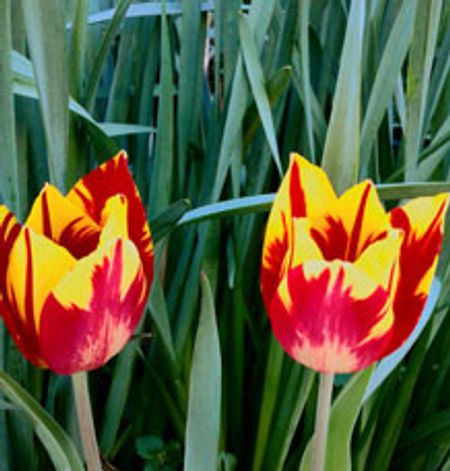
SIGNS OF SPRING
This photo was taken last year in South Milwaukee and the tulips were some of the first full blossoms of the year! They caught my eye because of their beautiful and distinct colors. I believe the featured tulips are a type of "burning heart" tulips and are a mid-spring blossom.
Amber Wilbur
Cudahy

MOURNING MEETING
We've always had mourning doves around here but I never saw them grouped like this before — 16 in all I counted circled on the mulch under a maple tree in our backyard. They all appear to be facing out from the circle (on guard?).
The mulch under the maple is raw wood chips so I suppose it's composting a bit and giving off a little heat. Cool and rainy this a.m. I figure maybe they are starting to flock together for migration time, maybe a layover through the night. They all flew away together after about 15 minutes.
The ducks and geese have been running premigration flights over the house for the last week or so. Winter is coming too fast for me. Give me about three months of fall first at least.
Mark Lang
Menomonee Falls
DNR wildlife biologist Ryan Brady provides this explanation: "Although difficult to say with certainty, the image appears to show a number of juvenile doves. This suggests the flock represents several family groups associating with each other, which is not uncommon, especially as fall approaches. The birds were likely able to stay drier, and perhaps warmer, on the mulch vs. the longer wet grass. Flocking up indeed provides many eyes for spotting Cooper's hawks, foxes and other predators, although not to the extreme that bobwhite quail coveys do!"
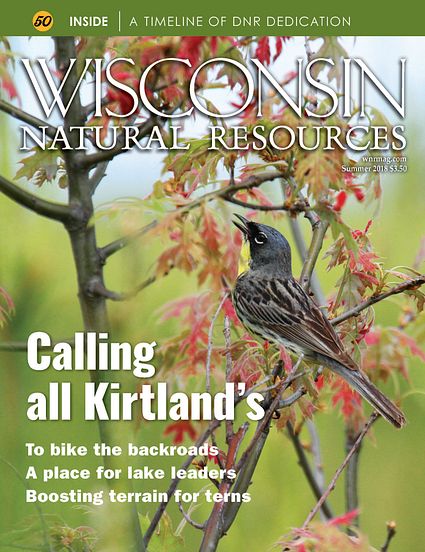
COMPLIMENTS FROM THE CLASSROOM
I am emailing you as a part of a class I am enrolled in for school, where I had to compare two different magazines of my choice. While comparing this magazine with one completely opposite, it made me appreciate the amount of information and detail you include in the magazine.
I am a person that usually doesn't take the time to read a magazine but learned that most magazines are filled with ads and unimportant information, unlike Wisconsin Natural Resources. I just wanted to take the time to note that you guys do a great job with your magazine, which highlights a lot of beautiful areas throughout Wisconsin while also demonstrating all the opportunities to take part in within the outdoor landscape of our state. Thank you!
Mikayla Endres
Lone Rock
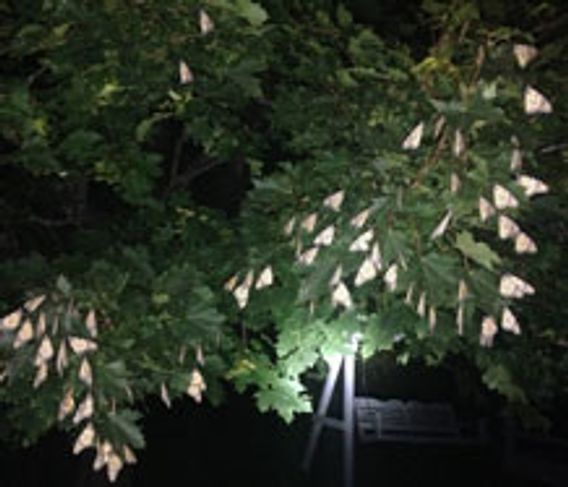
OVERNIGHT BUTTERFLY BOARDING
One evening in September last year, at the peak of the bloom of the goldenrod, monarch butterflies kept fluttering around and gathering on part of a tree in my backyard. That night, there were a couple hundred gathered on a few branches. In the morning, the first to be in the sun were the first to fly away.
I have 3 acres, of which 2 acres are native prairie plants, mostly goldenrod, with scattered milkweed, thistle and other wildflowers and shrubs. I have fond memories of monarch butterflies and caterpillars from childhood — have noticed the decline in their numbers. Hoping they survive!
Mark Howe
Hobart
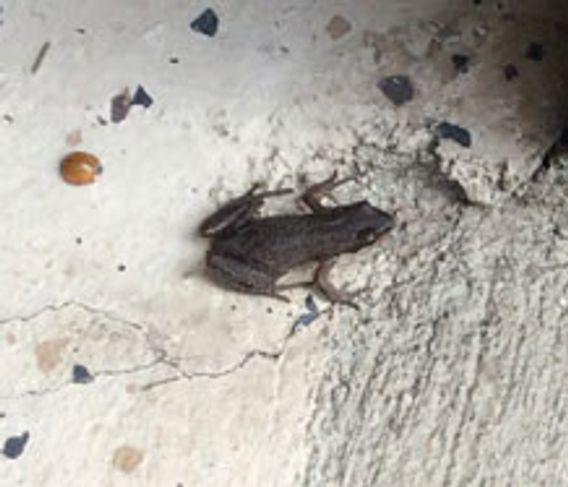
NAME THAT FROG
Today is Dec. 19 and above-average temperatures over the past month or so. I have seen this little guy in my unheated out-building whenever we have nice weather. Not sure where he lives within the building. Today I counted four of these frogs within my building. Can you help me identify what they are and how unusual it is to see them in December? You may notice by the ladybug in the picture how small these frogs are. The bug in the pic was not intentional, just an odd year to still be seeing bugs so late. Thank you.
Mark Zuberbuehler
Kenosha County
Richard Staffen, a conservation biologist with DNR's Natural Heritage Conservation Program responds: "Dear Mark, verified with a few other herpetologists and we agree this is a chorus frog. It is not uncommon to see them active during winter months during these warm spells. The chorus frog overwinters under debris (rocks, logs, duff) or in cracks/crevices where they try to get below the frost line, but can easily emerge or stay active as long as the weather permits."

CREATURES OF RARE BEAUTY
When you walk through the woods of northern Wisconsin and spot one of these white deer, it is a haunting experience. To see two together is a real treat. This photograph was taken near Boulder Junction.
Mark Boettcher
Brookfield
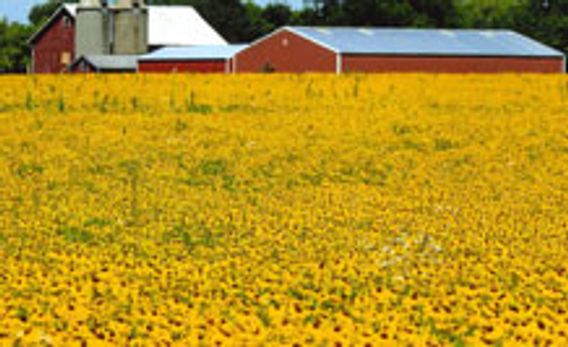
PRETTY, WITH A PURPOSE
I enjoy driving the Wisconsin back roads year round. Last summer, I was driving along Highway F out of Ixonia going south. Just before West River Road, there is a farm on your left. I was surprised by the beautiful, brilliant yellow field of black-eyed susans and other wildflowers. I challenged myself to find the owner of these fields so I could share some of the photos.
The farmer was thrilled to get the photos and tell me of the project he started with the Oconomowoc Watershed Protection Program. Unfortunately, I didn't get this nice farmer's name. I did learn about the watershed program. A few other area farmers are also participating. The farmers are filling their fields with wildflowers that have deep roots. The roots will help hold back all types of water runoff. I was very pleased to learn that farmers are actively working with their area watershed groups to clean their local water runoff from area creeks and such.
Wendy Kubokawa-Wells
Watertown
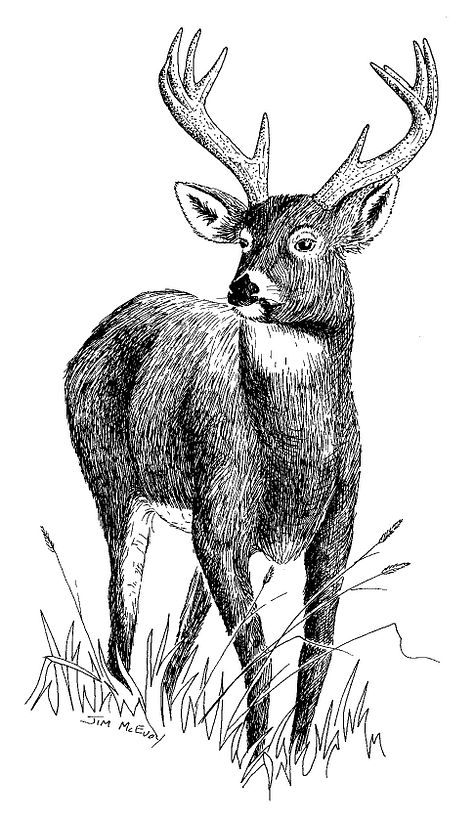 © JIM MCEVOY
© JIM MCEVOYPASS THE BUCK
What a great article Ron Weber wrote in your 2018 Winter edition ("Buck of a lifetime"). I, too, have dreamed of a buck of a lifetime and although one has not appeared in front of me, I, like him, have aimed and passed on a few bucks that have come before me. It's a special feeling to let them walk and live another day and gives true meaning to hunter ethics. By his action, he has now joined a special group of hunters that end the hunt not with a shot but with a memory of a lifetime!
Roy Lindeman
Green Bay
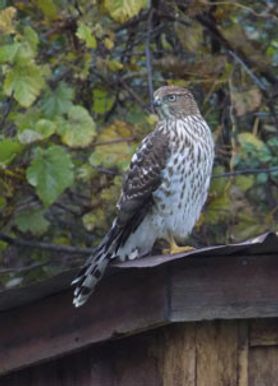

COUPLE OF COUNTRY BIRDS
Here is a picture of a Cooper's hawk that landed on top of the outhouse I built for storing gardening tools. I also found another picture that I thought you would appreciate seeing. We live out in a country subdivision between Milton and Janesville, and we have frequent turkey visitors. This one would stop by and peck on our patio window.
Elton Duffy
Milton
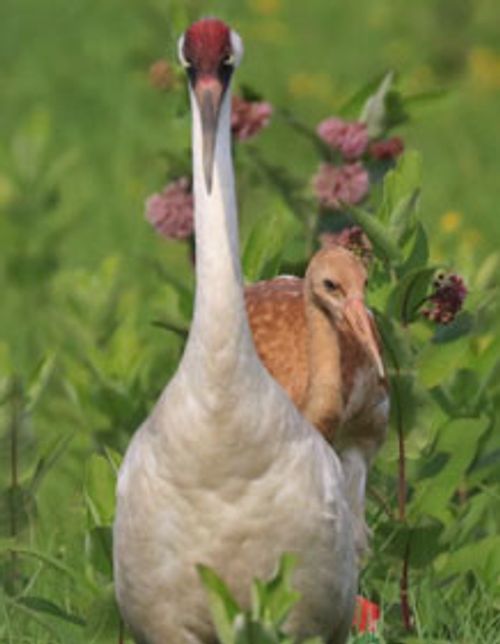
WHOOPING CRANE FAMILY LIFE
Hi, I am a nature photographer in Rome, Wisconsin. This past year, I have been making a photo history of the local whooping crane family, a slide show that shows the progression of the chick from a little fuzz ball to a bird that is capable of controlled flight. It shows the different terrain that the cranes use, some of the foods that are consumed and the daily life of the family unit.
Bob Stoil
Rome
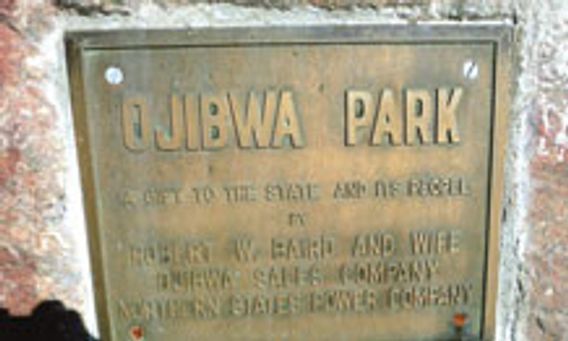
THANKS FOR THE GIFT
I enjoyed reading about the three generations of the Ruegger family ("DNR memoirs," Fall 2018). However, it seems you left out some information about the benefactors of the Ojibwa Park — see my picture. I don't know the details of the funding of the Sawyer County wayside park, but you should have mentioned the three parties listed on the marker (Robert W. Baird and his wife, the Ojibwa Sales Co., and Northern States Power). It is a lovely sight and the township campground on the south side of the highway is superior to the DNR campgrounds in many respects. P.S., enjoy the magazine very much!
John G. Powles
Middleton
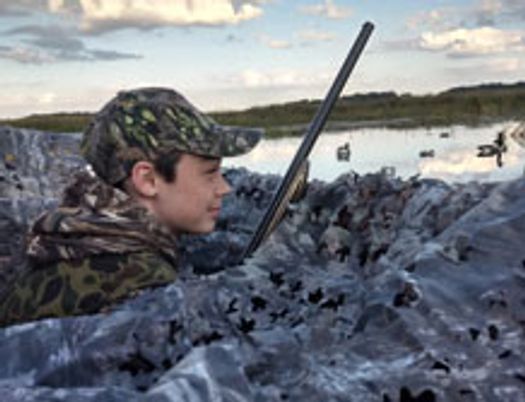
HOOKED ON THE HUNT
We wanted to share a picture of our son Matthew, 14, enjoying a morning waterfowl hunt. This picture was taken during the two-day youth hunt. We are grateful for the opportunity to participate in such a fantastic program to introduce our youth to Wisconsin's great hunting tradition. He's hooked!
William and Andrea Muench
Turtle Lake

